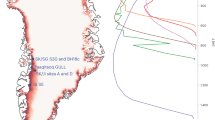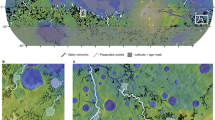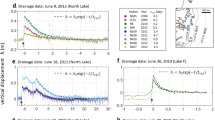Abstract
Water-driven fracture propagation beneath supraglacial lakes rapidly transports large volumes of surface meltwater to the base of the Greenland Ice Sheet1. These drainage events drive transient ice-sheet acceleration1,2,3 and establish conduits for additional surface-to-bed meltwater transport for the remainder of the melt season1,4,5,6. Although it is well established that cracks must remain water-filled to propagate to the bed7,8,9, the precise mechanisms that initiate hydro-fracture events beneath lakes are unknown. Here we show that, for a lake on the western Greenland Ice Sheet, drainage events are preceded by a 6–12 hour period of ice-sheet uplift and/or enhanced basal slip. Our observations from a dense Global Positioning System (GPS) network allow us to determine the distribution of meltwater at the ice-sheet bed before, during, and after three rapid drainages in 2011–2013, each of which generates tensile stresses that promote hydro-fracture beneath the lake. We hypothesize that these precursors are associated with the introduction of meltwater to the bed through neighbouring moulin systems (vertical conduits connecting the surface and base of the ice sheet). Our results imply that as lakes form in less crevassed, interior regions of the ice sheet10,11,12,13,14, where water at the bed is currently less pervasive5,14,15,16, the creation of new surface-to-bed conduits caused by lake-draining hydro-fractures may be limited.
This is a preview of subscription content, access via your institution
Access options
Subscribe to this journal
Receive 51 print issues and online access
$199.00 per year
only $3.90 per issue
Buy this article
- Purchase on Springer Link
- Instant access to full article PDF
Prices may be subject to local taxes which are calculated during checkout




Similar content being viewed by others
References
Das, S. B. et al. Fracture propagation to the base of the Greenland Ice Sheet during supraglacial lake drainage. Science 320, 778–781 (2008)
Doyle, S. H. et al. Ice tectonic deformation during the rapid in situ drainage of a supraglacial lake on the Greenland Ice Sheet. Cryosphere 7, 129–140 (2013)
Tedesco, M. et al. Ice dynamic response to two modes of surface lake drainage on the Greenland ice sheet. Environ. Res. Lett. 8, 34007 (2013)
Joughin, I. et al. Seasonal speedup along the western flank of the Greenland Ice Sheet. Science 320, 781–783 (2008)
Joughin, I. et al. Influence of ice-sheet geometry and supraglacial lakes on seasonal ice-flow variability. Cryosphere 7, 1185–1192 (2013)
Andrews, L. C. et al. Direct observations of evolving subglacial drainage beneath the Greenland Ice Sheet. Nature 514, 80–83 (2014)
Krawczynski, M. J., Behn, M. D., Das, S. B. & Joughin, I. Constraints on the lake volume required for hydro-fracture through ice sheets. Geophys. Res. Lett. 36, L10501 (2009)
Weertman, J. Can a water-filled crevasse reach the bottom surface of a glacier? In Symp. Hydrology of Glaciers 139–145 (International Association of Scientific Hydrology, 1973)
Van Der Veen, C. J. Fracture propagation as means of rapidly transferring surface meltwater to the base of glaciers. Geophys. Res. Lett. 34, L01501 (2007)
Sundal, A. V. et al. Evolution of supra-glacial lakes across the Greenland Ice Sheet. Remote Sens. Environ. 113, 2164–2171 (2009)
Howat, I. M., de la Peña, S., van Angelen, J. H., Lenaerts, J. T. M. & van den Broeke, M. R. Expansion of meltwater lakes on the Greenland Ice Sheet. Cryosphere 7, 201–204 (2013)
Fitzpatrick, A. A. W. et al. A decade (2002–2012) of supraglacial lake volume estimates across Russell Glacier, west Greenland. Cryosphere 8, 107–121 (2014)
Parizek, B. R. & Alley, R. B. Implications of increased Greenland surface melt under global-warming scenarios: ice-sheet simulations. Quat. Sci. Rev. 23, 1013–1027 (2004)
Leeson, A. A. et al. Supraglacial lakes on the Greenland Ice Sheet advance inland under warming climate. Nature Clim. Change 5, 51–55 (2015)
Bartholomew, I. D. et al. Seasonal variations in Greenland Ice Sheet motion: inland extent and behaviour at higher elevations. Earth Planet. Sci. Lett. 307, 271–278 (2011)
Doyle, S. H. et al. Persistent flow acceleration within the interior of the Greenland Ice Sheet. Geophys. Res. Lett. 41, 899–905 (2014)
Zwally, H. J. et al. Surface melt-induced acceleration of Greenland Ice-Sheet flow. Science 297, 218–222 (2002)
Bartholomew, I. et al. Short-term variability in Greenland Ice Sheet motion forced by time-varying meltwater drainage: implications for the relationship between subglacial drainage system behavior and ice velocity. J. Geophys. Res. 117, F03002 (2012)
Hoffman, M. J., Catania, G., a, Neumann, T., a, Andrews, L. C. & Rumrill, J. a. Links between acceleration, melting, and supraglacial lake drainage of the western Greenland Ice Sheet. J. Geophys. Res. 116, F04035 (2011)
Selmes, N., Murray, T. & James, T. D. Fast draining lakes on the Greenland Ice Sheet. Geophys. Res. Lett. 38, 1–5 (2011)
Smith, L. C. et al. Efficient meltwater drainage through supraglacial streams and rivers on the southwest Greenland ice sheet. Proc. Natl Acad. Sci. USA 112, 1001–1006 (2015)
Pimentel, S. & Flowers, G. E. A numerical study of hydrologically driven glacier dynamics and subglacial flooding. Proc. R. Soc. A 467, 537–558 (2010)
Tsai, V. C. & Rice, J. R. A model for turbulent hydraulic fracture and application to crack propagation at glacier beds. J. Geophys. Res. 115, F03007 (2010)
Segall, P. & Matthews, M. Time dependent inversion of geodetic data. J. Geophys. Res. 102, 22391–22409 (1997)
Bamber, J. L. et al. A new bed elevation dataset for Greenland. Cryosph. 7, 499–510 (2013)
Catania, G. A., Neumann, T. A. & Price, S. F. Characterizing englacial drainage in the ablation zone of the Greenland ice sheet. J. Glaciol. 54, 567–578 (2008)
Clason, C., Mair, D. W. F., Burgess, D. O. & Nienow, P. W. Modelling the delivery of supraglacial meltwater to the ice/bed interface: application to southwest Devon Ice Cap, Nunavut, Canada. J. Glaciol. 58, 361–374 (2012)
Arnold, N. S., Banwell, F. & Willis, I. C. High-resolution modelling of the seasonal evolution of surface water storage on the Greenland Ice Sheet. Cryosphere 8, 1149–1160 (2014)
Poinar, K. et al. Limits to future expansion of surface-melt-enhanced ice flow into the interior of western Greenland. Geophys. Res. Lett. 42, 1800–1807 (2015)
Sergienko, O. V. Glaciological twins: basally controlled subglacial and supraglacial lakes. J. Glaciol. 59, 3–8 (2013)
Lampkin, D. J. & VanderBerg, J. A preliminary investigation of the influence of basal and surface topography on supraglacial lake distribution near Jakobshavn Isbrae, western Greenland. Hydrol. Processes 25, 3347–3355 (2011)
Price, S. F., Payne, A. J., Catania, G. A. & Neumann, T. A. Seasonal acceleration of inland ice via longitudinal coupling to marginal ice. J. Glaciol. 54, 213–219 (2008)
Chen, G. GPS Kinematics Positioning for the Airborne Laser Altimetry at Long Valley, California. PhD thesis, Massachusetts Institute of Technology. (1998)
Bevis, M. et al. Bedrock displacements in Greenland manifest ice mass variations, climate cycles and climate change. Proc. Natl Acad. Sci. USA 109, 11944–11948 (2012)
Moratto, Z. M., Broxton, M. J., Beyer, R. A., Lundy, M. & Husmann, K. In 41st Lunar and Planetary Science Conference 2364 (Lunar and Planetary Institute. (2010)
Van Angelen, J. H., van den Broeke, M. R., Wouters, B. & Lenaerts, J. T. M. Contemporary (1960–2012) evolution of the climate and surface mass balance of the Greenland Ice Sheet. Surv. Geophys. 35, 1155–1174 (2013)
Okada, Y. Surface deformation due to shear and tensile faults in a half-space. Bull. Seismol. Soc. Am. 75, 1135–1154 (1985)
Miyazaki, S. A transient subduction zone slip episode in southwest Japan observed by the nationwide GPS array. J. Geophys. Res. 108, 2087 (2003)
Miyazaki, S., Mcguire, J. J. & Segall, P. Seismic and aseismic fault slip before and during the 2011 off the Pacific coast of Tohoku Earthquake. Earth Planets Space 63, 637–642 (2011)
Van der Veen, C. J. Fracture mechanics approach to penetration of surface crevasses on glaciers. Cold Reg. Sci. Technol. 27, 31–47 (1998)
Hobbs, P. V. Ice Physics 258 (Clarendon, 1974)
Kanamori, H. Magnitude scale and quantification of earthquakes. Tectonophysics 93, 185–199 (1983)
Glen, J. W. The creep of polycrystalline ice. Proc. R. Soc. Lond. A 228, 519–538 (1955)
Budd, W. F. & Jacka, T. H. A review of ice rheology for ice sheet modeling. Cold Reg. Sci. Technol. 16, 107–144 (1989)
Kamb, B. & Echelmeyer, K. A. Stress-gradient coupling in glacier flow: I. Longitudinal averaging of the influence of ice thickness and surface slope. J. Glaciol. 32, 267–284 (1986)
Hindmarsh, R. C. A. The role of membrane-like stresses in determining the stability and sensitivity of the Antarctic ice sheets: back pressure and grounding line motion. Phil. Trans. R. Soc. A 364, 1733–1767 (2006)
Acknowledgements
Support was provided by the National Science Foundation’s Office of Polar Programs (NSF-OPP) and National Aeronautics and Space Administration’s (NASA’s) Cryospheric Sciences Program through ARC-0520077, ARC-1023364, and NNX10AI30G to S.B.D. and M.D.B., and through ARC-0520382, ARC-1023382, and NNX10AI33G to I.J. M.A.K. is a recipient of an Australian Research Council Future Fellowship (project number FT110100207). WorldView image data used for this work was provided by the Polar Geospatial Center at the University of Minnesota with support from NSF grant ANT-1043681. L.A.S. was also supported by a National Science Foundation Graduate Research Fellowship. Logistical and instrumental support was provided by UNAVCO, PASSCAL, and CH2MHILL Polar Field Services. We thank J. Carmichael, L. Kehrl, T. Moon, and K. Poinar for their assistance.
Author information
Authors and Affiliations
Contributions
M.D.B., S.B.D., and I.J. conceived the study. L.A.S., M.D.B., S.B.D., I.J., and D.S. performed the fieldwork. L.A.S., T.H., and M.A.K. processed and analysed the GPS data. J.J.M. and L.A.S. developed the NIF. D.S. created the digital elevation models. L.A.S., M.D.B., S.B.D., I.J., and J.J.M. interpreted the results. L.A.S. wrote the paper. All authors commented on the paper.
Corresponding author
Ethics declarations
Competing interests
The authors declare no competing financial interests.
Extended data figures and tables
Extended Data Figure 1 WorldView image taken on 21 July 2011 of an empty North Lake basin after the 2011 rapid drainage event.
Yellow outline shows M1 and M2 location along the hydro-fracture trace (endpoints marked by black arrows). Yellow triangles mark GPS stations within the map area. Image copyright 2015 DigitalGlobe.
Extended Data Figure 2 Images and DEM of 2011 and 2013 North Lake basin.
a (d), WorldView image chosen to map the 2011 (2013) North Lake pre-drainage shoreline position. b (e), WorldView image of an empty North Lake basin obtained on 21 July 2011 (5 July 2013) used to create the 2011 (2013) North Lake DEM. c (f), The 2-m horizontal resolution DEM (2-m vertical contours in black) for the North Lake region, with the North Lake shoreline (red), M1 (yellow), and hydro-fracture trace (blue) mapped over contours. Images copyright 2015 DigitalGlobe.
Extended Data Figure 3 North Lake depths in 2011 and 2013.
Two-metre resolution DEMs were created from the first available post-drainage WorldView stereo pair obtained of the region in (a) 2011 and (b) 2013. Shoreline positions from 2011 and 2013 derived from last pre-drainage WorldView or TerraSAR-X images obtained over the region are shown in red. The last pre-drainage WorldView image for 2011 occured 2 days before the drainage event on 17 June 2011; the last pre-drainage SAR image for 2013 occured 1 day before the event on 17 June 2013. Filling the empty basin DEM up to the greatest known pre-drainage shoreline extent generated North Lake depths (1-m vertical contours in black) in relation to the greatest known pre-drainage shoreline extents and were used to calculate minimum 2011 and 2013 North Lake pre-drainage volumes. The trace of the vertical hydro-fracture crack is shown in grey; M1 is outlined in yellow.
Extended Data Figure 4 The 2012 basal slip and cavity opening at hydro-fracture initiation and maximum hydro-fracture opening.
NIF-calculated (a) extra basal slip accumulated, (b) basal cavity opening, and (c) hydro-fracture crack opening at the time of the 2012 (a–c) hydro-fracture initiation and (d–f) maximum hydro-fracture opening (time points shown in Fig. 2a). Moulin location, last known lake shoreline, GPS stations, and NIF vertical crack surface trace derived from SAR imagery are shown as a yellow circle, blue line, black triangles, and black line, respectively. Vector fields show GPS (NIF) displacement less background velocities in black (green) for (a) the period between the start of the precursor and hydro-fracture initiation, and (d) the period between hydro-fracture initiation and maximum hydro-fracture opening. Error ellipses of 1 sigma are shown for the GPS displacements (blue ellipses). Basal sub-elements are 0.83 km by 0.83 km, resulting in 144 sub-elements over a 10 km × 10 km region.
Extended Data Figure 5 The 2013 basal slip and cavity opening at hydro-fracture initiation and maximum hydro-fracture opening.
NIF-calculated (a) extra basal slip accumulated, (b) basal cavity opening, and (c) hydro-fracture crack opening at the time of the 2013 (a–c) hydro-fracture initiation and (d–f) maximum hydro-fracture opening (time points shown in Fig. 2a). Moulin location, last known lake shoreline, GPS stations, and NIF vertical crack surface trace derived from SAR imagery are shown as a yellow circle, blue line, black triangles, and black line, respectively. Vector fields show GPS (NIF) displacement less background velocities in black (green) for (a) the period between the start of the precursor and hydro-fracture initiation, and (d) the period between hydro-fracture initiation and maximum hydro-fracture opening. Error ellipses of 1 sigma are shown for the GPS displacements (blue ellipses). Basal sub-elements are 0.83 km by 0.83 km, resulting in 144 sub-elements over a 10 km by 10 km region.
Extended Data Figure 6 The 2011 station time series.
a–c, Flowline, crack-normal, and uplift GPS displacements (in metres) (grey stars), respectively, for stations used in the 2011 NIF. NIF station fits from the three displacement sources (Extended Data Fig. 7) shown in red, and NIF station fits including Li(t) (random benchmark wobble term) are shown in black. Stations are ordered roughly north to south on the y axis, offset by 0.5 m.
Extended Data Figure 7 The 2011 NL08 and NL04 Station flowline, crack-normal, and uplift displacements computed from NIF displacement sources.
Flowline, crack-normal, and uplift GPS displacements less background velocity field (grey stars) are plotted the for (a–c) NL04 and (d–f) NL08 over the 2 days before and 1 day after the 2011 rapid North Lake drainage. These stations are two examples chosen from the full array because they capture displacement on both the northern (NL04) and southern (NL08) side of the lake, are located at roughly the same longitude as M1, and are within 2 km of the lake. NIF-calculated surface ice displacements at NL04 and NL08 stations from the three displacement sources are plotted for the (red) hydro-fracture crack opening, (green) basal cavity opening, and (blue) extra basal slip. The sum of all three NIF displacement sources is shown in black.
Extended Data Figure 8 MLE of NIF hyperparameters.
MLE of the vertical hydro-fracture plane temporal smoothing parameter, α, for (a) 2011, (b) 2012, and (c) 2013 NIF. The MLE corresponds with the minimum value on the −2 × likelihood plots19. Minimum likelihood estimates are outlined in red circles, with the value used in each year’s inversion outlined indicated with a black diamond (Methods).
Extended Data Figure 9 Stress changes across North Lake basin.
Stress changes during (a) supraglacial lake formation, (b) rapid drainage precursor, and (c) hydro-fracture opening.
Supplementary information
Hydro-fracture crack opening, basal cavity opening, and additional basal slip during the 2011 North Lake rapid drainage.
Video spanning the two days prior and one day following the 2011 drainage event, depicting (d) opening along the hydro-fracture crack as a percentage of the maximum opening (Extended Data Table 1) of the hydro-fracture crack, (e) basal cavity opening, and (f) additional basal slip above background velocity values for all NIF subelements. GPS stations are shown with black triangles; station NL08 is shown as a white triangle. The yellow box outlines the subelement of maximum opening, uplift, or slip within the hydro-fracture crack, basal cavity opening, and basal slip planes, respectively, once opening or slip has exceeded a threshold value of 20% of maximum opening for the hydro-fracture crack and 0.2 m basal cavity opening or additional basal slip for the basal planes. Station fit between GPS station NL08 and the NIF is shown in the left column, with NL08 (a) crack-normal, (b) uplift, and (c) along flowline displacements less background velocities in grey, and the NIF inversion at the location of NL08 in black. The blue diamond follows the NIF inversion at the location of NL08 along the time of the NIF panels. “Start of Precursor,” “Hydro-fracture Initiation,” and “Maximum Hydro-fracture Opening” times are marked as vertical grey lines are at the same time points delineated in Figure 2 and Extended Data Table 1. (MP4 5191 kb)
Hydro-fracture crack opening, basal cavity opening, and additional basal slip during the 2012 North Lake rapid drainage.
This video shows the same as Video 1 but for the 2012 North Lake rapid drainage. (MP4 4766 kb)
Hydro-fracture crack opening, basal cavity opening, and additional basal slip during the 2013 North Lake rapid drainage.
This video shows the same as Video 1 but for the 2013 North Lake rapid drainage. (MP4 8155 kb)
Source data
Rights and permissions
About this article
Cite this article
Stevens, L., Behn, M., McGuire, J. et al. Greenland supraglacial lake drainages triggered by hydrologically induced basal slip. Nature 522, 73–76 (2015). https://doi.org/10.1038/nature14480
Received:
Accepted:
Published:
Issue Date:
DOI: https://doi.org/10.1038/nature14480
This article is cited by
-
Threshold response to melt drives large-scale bed weakening in Greenland
Nature (2022)
-
Tidewater-glacier response to supraglacial lake drainage
Nature Communications (2022)
-
Widespread distribution of supraglacial lakes around the margin of the East Antarctic Ice Sheet
Scientific Reports (2019)
-
Hydrology and the future of the Greenland Ice Sheet
Nature Communications (2018)
-
Cascading lake drainage on the Greenland Ice Sheet triggered by tensile shock and fracture
Nature Communications (2018)
Comments
By submitting a comment you agree to abide by our Terms and Community Guidelines. If you find something abusive or that does not comply with our terms or guidelines please flag it as inappropriate.



